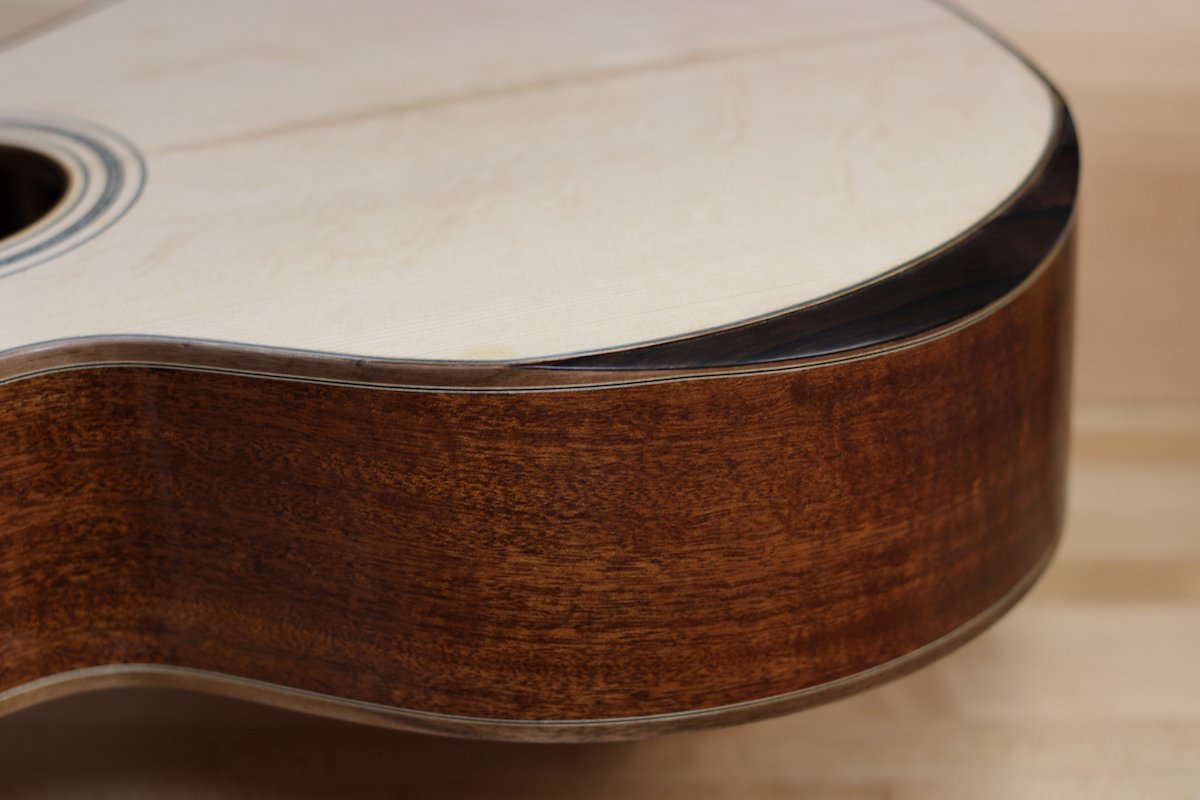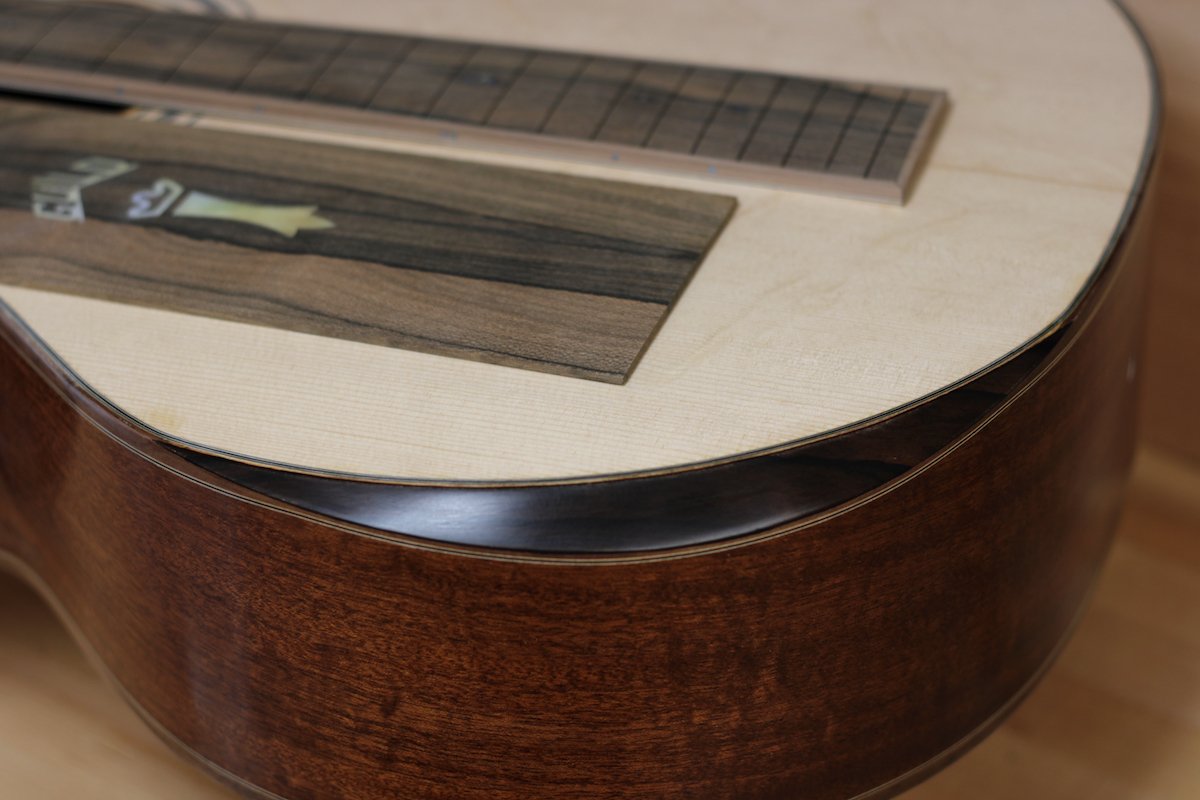Yes.Christopher, do you build acoustics from scratch? Like your own designs etc?
You are using an out of date browser. It may not display this or other websites correctly.
You should upgrade or use an alternative browser.
You should upgrade or use an alternative browser.
1975 Guild F-212 Makeover
- Thread starter Christopher Cozad
- Start date
Westerly Wood
Venerated Member
- Joined
- Mar 21, 2007
- Messages
- 13,426
- Reaction score
- 6,626
- Guild Total
- 2
got a website?Yes.
I grew up around logging, milling, woodworking, cabinet-making, etc. and I had no idea that natural Cherry was such a varigated, light and dark appearance until I was well into my late 20s. I had always associated a “Cherry” finish with that deep red wine / Bing Cherry juice color that everyone was wiping all over everything (or so it seemed). Guild called it a “Cabernet” finish. “Dark” is right. It covers loads of irregularities, so it makes sense to me from that perspective. Today I tend to associate it with Avocado and Harvest Gold kitchen appliances, or Mauve carpet, upholstered furniture, and draperies....I have a cherry-paneled den that is darker than a dungeon. I wish I could strip it all down and do a light stain on it. Most folks usually just paint over it, but I just can't bring myself. I'm too lazy anyway.
Rob Reilly
Junior Member
This is exactly what I want to do to my '73 F212XL. There is a lot of incidental chip damage on it and I don't like that Cabernet red color. But it appears that you just used a scraper, did not use a chemical stripper. Can you give more details about your process?This was one of the “Cabernet” tinted Mahogany Guilds. Whenever I encounter on of these things I start looking for my scraper to get that lacquer off! I want to see what is beneath.
This is exactly what I want to do to my '73 F212XL. There is a lot of incidental chip damage on it and I don't like that Cabernet red color. But it appears that you just used a scraper, did not use a chemical stripper. Can you give more details about your process?
Hi Rob,
I do NOT use chemical strippers of any kind.
I rely on a scraper developed by Al Caruth. (StewMac sells it, currently - https://www.stewmac.com/luthier-tools-and-supplies/types-of-tools/scrapers/stewmac-ultimate-scraper/). I will sharpen it several times during a session. Using a scraper, there are thousands of passes required to remove the finish, but the results are worth the effort.
Lacquer will dry to become impressively hard, almost “glass-like” hard, over time. It requires a razor-sharp scraper, a great deal of patience, and several hours to successfully remove. Short strokes with even pressure that remove narrow curls of material, working one section at a time, are necessary for best results. I never try to “git ‘er done!” quickly, as that will only end in frustration (or worse).
I have removed NCL finishes from so many guitars that I am very comfortable using an oscillating sander with 220 grit paper to just “scratch” the outer layer of lacquer on FLAT surfaces only (I use a Festool ETS 150/3 EQ Sander fitted with Festool P220 Granat paper, connected to a Festool Cleantec CT 48 E vacuum). This reduces my scraper time by about 1/3 - and that really adds up over the guitars, over the years!
Here is a link to an article about another Guild I scraped clean. It includes some photos (it is a really long article, so the link should take you to the section titled “Finish Removal”):
Cozad Guitars - 1999 Guild JF65-12 Re-imagined
1999 Guild JF65-12 Overhaul. An article by Cozad Guitars.
I settled on a Ziricote theme for the headplate (faceplate on the headstock), fretboard, bridge, and (new) arm bevel (the Walnut was putting me to sleep!).
Ziricote is so visually interesting…
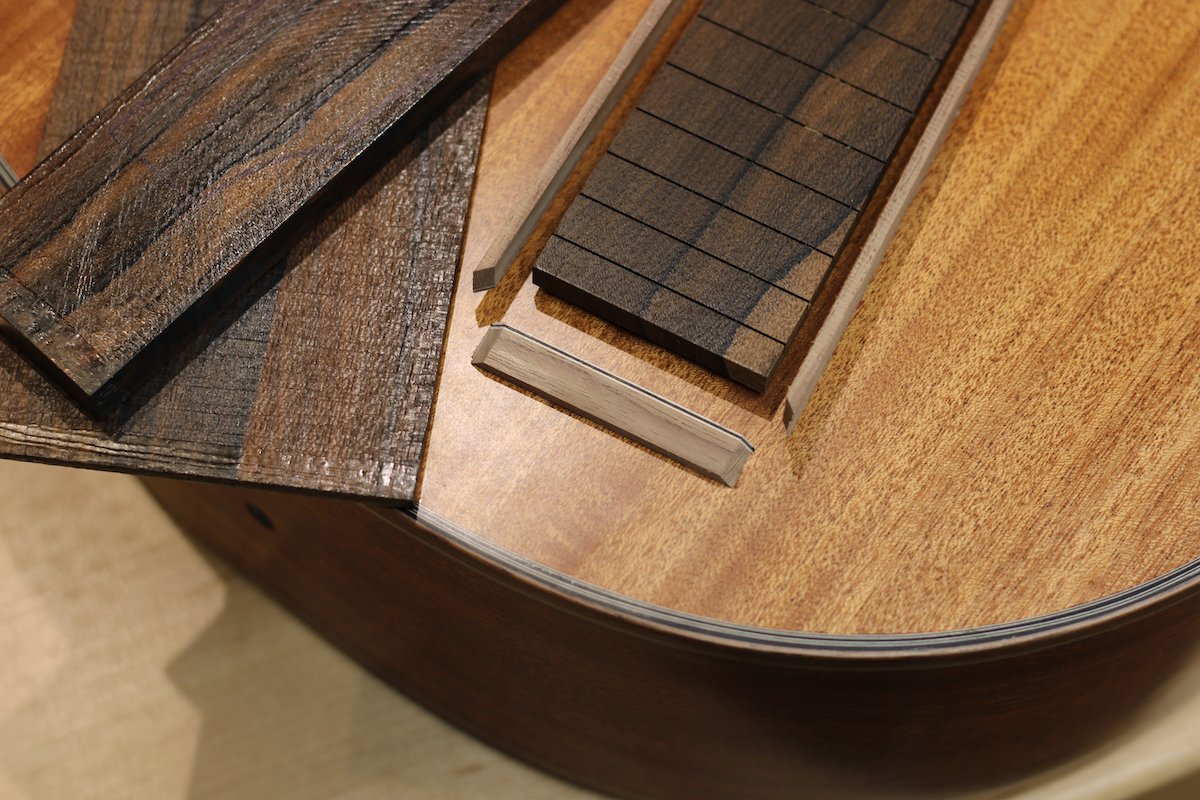
I tried several wood combinations for the Chesterfield inlay, and they all either disappeared in the pattern or clashed horribly. Nothing looked quite as nice and clean as this Mother of Pearl. So here is the new headplate:
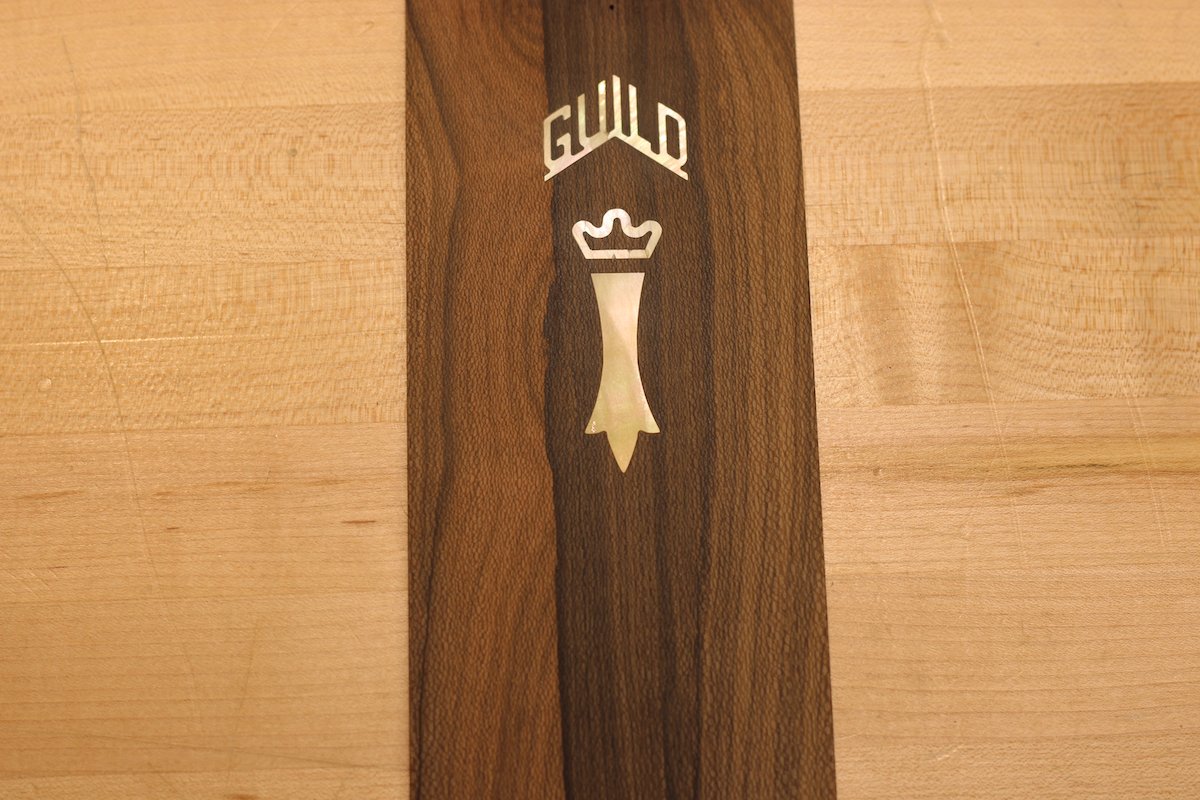
And I added just a touch of shell to the Ziricote fretboard. It needed position markers, so I inlaid tiny dots at 3, 5, 7, 9, 15, and 17… along with a surprise at the 12th fret.
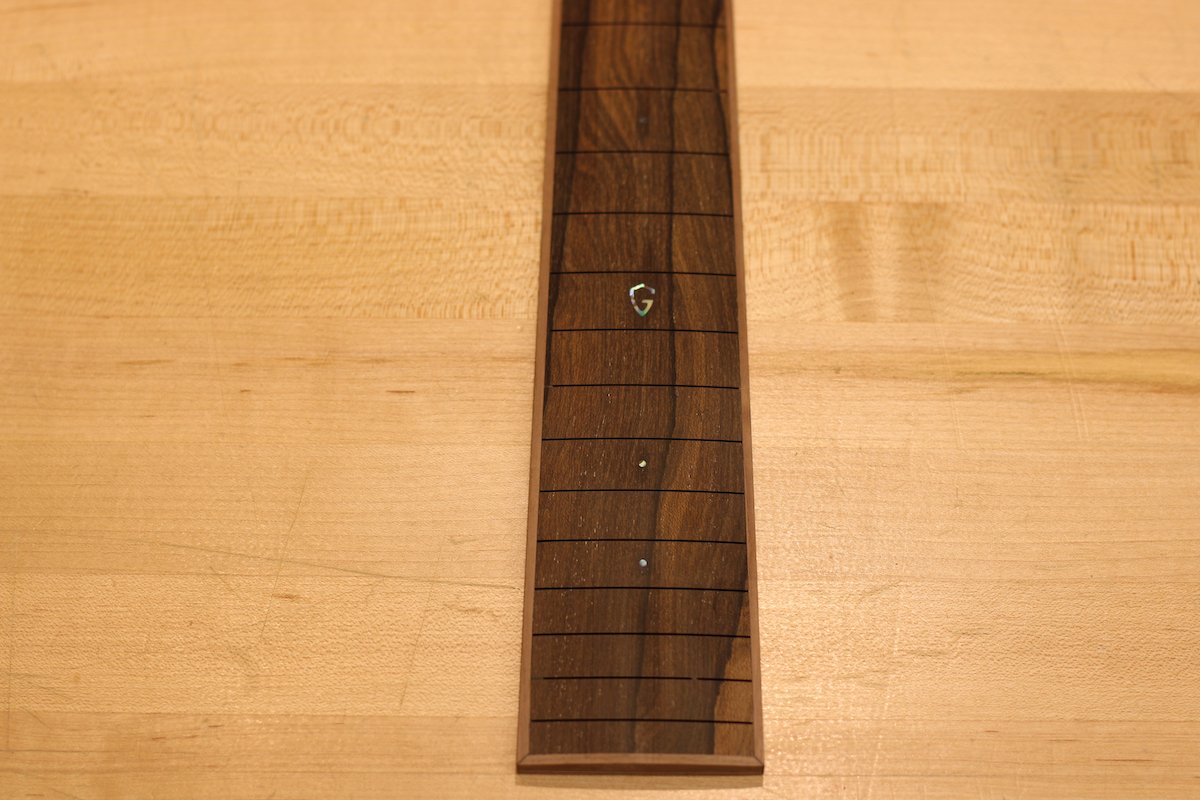
Ziricote is so visually interesting…

I tried several wood combinations for the Chesterfield inlay, and they all either disappeared in the pattern or clashed horribly. Nothing looked quite as nice and clean as this Mother of Pearl. So here is the new headplate:

And I added just a touch of shell to the Ziricote fretboard. It needed position markers, so I inlaid tiny dots at 3, 5, 7, 9, 15, and 17… along with a surprise at the 12th fret.

That's just glorious Christopher!
I have high hopes for this 12 string. It is getting prettier and prettier, the closer it gets to completion. Of course, nobody gets to hear it until the very last step, after everything is all done. But that is just part of the fun, part of the suspenseful process of building stringed instruments.
Lookin' terrific, Chris! Is Ziricote up to the task as a fretboard? Hard enough, etc.I have high hopes for this 12 string. It is getting prettier and prettier, the closer it gets to completion. Of course, nobody gets to hear it until the very last step, after everything is all done. But that is just part of the fun, part of the suspenseful process of building stringed instruments.
...Is Ziricote up to the task as a fretboard? Hard enough, etc.
Though not quite as hard as Rosewood, Ziricote is much harder than Maple, which has been associated with fretboards for longer than I have!
WaltW
Member
Quite spectacular looking Chris! I cannot wait to see that headplate with finish coating on it and the fretboard will look amazing with a little oil to make the grain stand out. where did the fretboard "G" come from........did you cut that yourself?
Agreed, Walt. When all the wood darkens up, the look will be consistent, and it should be really lovely.
I think it may have taken me longer to cut that little “G” than it did for me to make the fretboard, cut the Mother of Pearl, and inlay the headplate - all combined! Man, that thing is tiny. It is one piece of Paua (abalone) with no breaks. And tiny shell is soooo fragile. Once I had it cut and filed to size, I had to cut the pocket for it to sit in. By that stage of the process, the pressure to not make a mistake is at maximum. But it came out well, I think.
I think it may have taken me longer to cut that little “G” than it did for me to make the fretboard, cut the Mother of Pearl, and inlay the headplate - all combined! Man, that thing is tiny. It is one piece of Paua (abalone) with no breaks. And tiny shell is soooo fragile. Once I had it cut and filed to size, I had to cut the pocket for it to sit in. By that stage of the process, the pressure to not make a mistake is at maximum. But it came out well, I think.
WaltW
Member
Back in the late 1980s I was into making fishing rods and 4 four weight fly rods received the letter initial of the person that I made it for. The letter was cut from Abalone that was glued to a piece of Oak for cutting with an adjustable frame jeweler's saw. The Oak was the only way I could cut the shell without it chipping. It was much more difficult than making the fancy thread wrap in front of the cork grip which could take as much as 8 hours.
Christopher, you have the patience of a saint.
Christopher, you have the patience of a saint.
